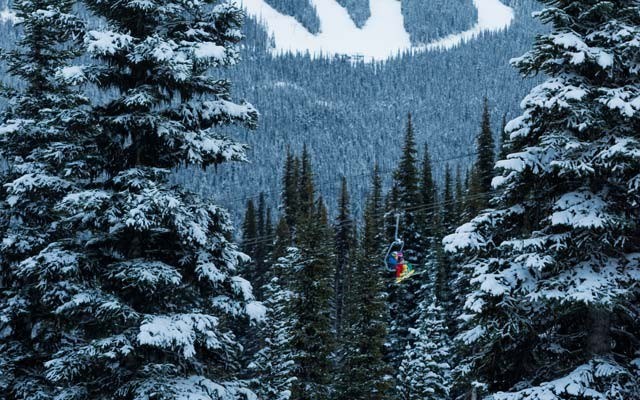We all know it is going to snow.
It always snows. Sometimes it is earlier than expected and sometimes it is later than we hope... but one day we wake up and the blanket of white that creates a whole new world of adventures for us finally stays on the ground and weighs down the evergreen branches of our gladed runs.
Despite the lack of snow in the valley, hundreds lined up for opening day last Saturday Nov. 22, and while we can all agree it wasn't great — and lining up to get down as well as up was annoying — most, nevertheless, headed to après feeling like the season was finally underway.
And just in time was the refrain overheard around town, as we readied ourselves for the U.S. Thanksgiving long weekend, a traditionally very busy time in Whistler.
Many businesses will no doubt be watching to see what U.S. visitor numbers are like given the decline reported by the Central Credit union a few months ago.
It's statistics reported that: "International travel to B.C. edged lower for a third consecutive month in August as fewer U.S. visitors contributed to a temporary pause in what has been a near two-year recovery uptrend.
"U.S. demand was the key dampener of travel during the month (August), falling about two per cent to 245,370 persons."
Of course, summer travel and winter travel are two different animals, and with the lower Canadian dollar and Whistler's aggressive pricing on stay and ski/board packages, the hope is that our American friends will choose Whistler as their ski and winter outdoor destination of choice.
But wishing can't make something so — and any successful business operator, big or small, knows the truth of that.
This understanding and knowing the fiercely competitive nature of tourism has kept Whistler Blackcomb continuing to reinvest in its product — last year it invested $18 million in new infrastructure and on-mountain upgrades, and this season will see $12 million spent on a new Whistler Village Gondola and the RFID pass system along with other improvements.
According to the Canada West Ski Areas Association, Whistler Blackcomb alone provides $405 million in annual tax revenues. But there is no getting away from the fact that ski numbers are flat. Over the past 10 years, annual skier visits have ranged from a low of 4,617,000 in 2004-2005 to 6,787,000 in 2007-2008. Last year, 6,472,000 skiers visited B.C.
Whistler is more than skiing though and that is a part of the message that must also be sold. It is a reality that must be embraced especially when faced with the statistics about where new tourist dollars are coming from.
That Central Credit Union report also found that: "While relative growth was strongest from North and Central America (excluding the U.S.), and the Caribbean at 20 per cent and led by Mexico, the vast majority of the gain came from Asia.
"Asian travel to B.C. represents about two-thirds of total overseas gains this year and is up about 12 per cent from a year ago. Tourist flows from China are up 27 per cent, to make up most of the gain.
"India has also grown as a source country with growth of 20 per cent, although this is off a considerably lower base. Even with slowing economic growth, these economies are growing enough to generate an increasing pool of middle- to- higher income households, that are fuelling global tourism demand."
By 2020, nearly one in five people on the planet will have the means to travel abroad, according to the UN World Tourism Organization.
These numbers are not going unnoticed ,as you can imagine.
David Lynn of the Canada West Ski Areas Association is hopeful that China will develop into a source of ski tourists.
China's ski industry is in its infancy but "their population is so massive that even a small percentage of that total coming to visit as skiers can have a big impact on our industry," he told the Province earlier this year.
According to a HarrisDecima report from 2012, it is a growing pastime with the 10,000 Chinese skiing in 1996 growing to five million in 2010 — that number is expected to double by 2015.
There are now over 70 ski resorts in China. It is seen as a luxury trend driven by new skiers and families who see shopping, dining and sightseeing as equal activities to skiing. At Chinese ski hills it is common to see the slopes full of people without any skis or snowboards, just there to experience snow and watch other people skiing.
In a 2011 Global Tourism Watch study, 12 per cent of China's likely visitors to Canada said they would probably visit Whistler during a trip to Canada. Eight per cent said they would likely visit Banff and five per cent would likely visit Jasper.
Destination B.C. (formerly Tourism B.C.) launched a whole new tourism strategy earlier this month with a branding message that encapsulates much of what Whistler represents to the tourist — a message that will resonate with Asian visitors.
The brand is no longer simply just "Super Natural" and "clean" but wild, and full of experiences. They can be the rhythmic scratch of your skinny skis on snow as you glide in the Callaghan Valley, or the sound of sleigh bells on a horse-drawn sleigh, or the feel of a snowflake on your skin as you melt into the waters of an outdoor spa area, just as well as the exhilaration of sliding downhill.
Whistler has all of it and more... but first we have to get people here.




